ArDOT Strike Team



RECENTLY, I WAS LOOKING FOR A PICTURE AND HAPPENED UPON A POEM THAT I’VE HAD SINCE I BEGAN WORK AT Ar DOT IN 1981. I have kept it all these years and every once in a while – it will surface in my keepsake papers. Whenever I read it – it never fails to inspire me to do better. I would like to share it with you.

"The longer I live, the more I realize the impact of attitude on life.
Attitude, to me, is more important than facts. It is more important than the past, than education, than money, than circumstances, than failures, than successes, than what other people think, say or do.
It is more important than appearance, giftedness or skill.
It will make or break a company... a church... a home.
The remarkable thing is we have a choice every day regarding the attitude we embrace for that day. We cannot change our past... we cannot change the fact that people will act in a certain way. We cannot change the inevitable. The only thing we can do is play the one string we have, and that is our attitude...
I am convinced that life is 10% what happens to me and 90% how I react to it. And so it is with you... we are in charge of our Attitudes”
All my best,
 Lorie H. Tudor, P.E., Director
Lorie H. Tudor, P.E., Director
 ATTITUDE by Charles Swindoll
ATTITUDE by Charles Swindoll
FRONT & BACK COVER: Snowy scene on State Highway 7.
EDITOR
David Nilles
David.Nilles@ardot.gov
STAFF WRITERS
Britni Padilla-Dumas
Britni.Padilla-Dumas@ardot.gov
Valerie Williams
Valerie.Williams@ardot.gov

Marrissa Miller
Marrissa.Miller@ardot.gov
Lamarie Rutelonis
Lamarie.Rutelonis@ardot.gov
Aimee Goode
Aimee.Goode@ardot.gov
PHOTOGRAPHER
Rusty Hubbard Russell.Hubbard@ardot.gov



Correspondence should be directed to: David.Nilles@ardot.gov
ARKANSAS HIGHWAYS
Public Information Office
P.O. Box 2261
Little Rock, AR 72203-2261
Arkansas Highways is published by and for employees of the Arkansas Department of Transportation as a medium of departmental news and other information. It is also distributed free of charge to the public upon request.

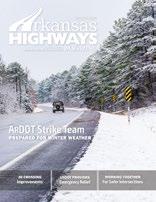
The Arkansas Department of Transportation (Department) complies with all civil rights provisions of federal statutes and related authorities that prohibit discrimination in programs and activities receiving federal financial assistance. Therefore, the Department does not discriminate on the basis of race, sex, color, age, national origin, religion (not applicable as a protected group under the Federal Motor Carrier Safety Administration Title VI Program), disability, Limited English Proficiency (LEP), or low-income status in the admission, access to and treatment in the Department's programs and activities, as well as the Department's hiring or employment practices. Complaints of alleged discrimination and inquiries regarding the Department's nondiscrimination policies may be directed to Joanna P. McFadden Section Head – EEO/ DBE (ADA/504/Title VI Coordinator), P. 0. Box 2261, Little Rock, AR 72203, (501)569-2298, (Voice/TTY 711), or the following email address: Joanna.McFadden@ardot.gov. Free language assistance for Limited English Proficient individuals is available upon request. This notice is available from the ADA/504/Title VI Coordinator in large print, on audiotape and in Braille.




OH, THE WEATHER OUTSIDE IS FRIGHTFUL," SO SAYS THE POPULAR HOLIDAY SONG. And indeed, it can be just that when ice and snow begin to accumulate on highways across the Natural State.
Long before the frozen precipitation begins to fall, you can rest assured that ArDOT’s District Maintenance crews are hard at work. They are the front line of defense, preparing the trucks with spreaders and plows, loading up with salt and sand, and driving targeted highway routes within their Districts clearing the roads of winter precipitation.
But that is just the beginning of ArDOT’s efforts when it comes to
battling frozen precipitation.
In addition to the District Maintenance crews, ArDOT now has a Winter Weather Strike Team standing by in central Arkansas waiting to spring into action where needed.
In fact, the more than 90 field personnel from the statewide striping, signing, milling and heavy bridge maintenance crews that make up the Strike Teams began conducting drills in early December, so they are ready when snow and ice arrive.
The Winter Weather Strike Team differs from District crews in that, as opposed to clearing a specific multi-county area, the team travels to areas across the state that need the most attention, no matter what part of the state that may be. The teams will receive a request from
District Engineers as the need arises and hit the road to assist those Districts as requested. They may be in central Arkansas one day and in southeast Arkansas the next following a storm as it moves across the state.
Each strike team is comprised of one multi-axle dump truck outfitted with a plow and salt spreaders, drivers, supervisors and a mechanic. Strike teams are supported by Equipment & Procurement maintenance trucks, mechanics and Districts where applicable.
“It is crucial that we do everything we can do to be prepared when winter weather hits,” explained Michael Kelly, ArDOT Staff Maintenance Engineer and
(continued on page 6)

Emergency Management Liaison Officer. “These drills help us see both our strengths and areas for improvement. It is our job to keep our roadways safe, and we take that responsibility seriously.”
The challenge of clearing the highways begins before the trucks ever leave the ArDOT campus. Crews must check their equipment to ensure it is in good working order, test communication capabilities, know what to do if there is an emergency and make sure to have flashlights, batteries, ice scrapers, flares, blankets, extra parts and tools on hand. Food and drink must also be considered when out on the icy roadways because like maintenance crews, the Winter Weather Strike teams battle the weather 24 hours a day.

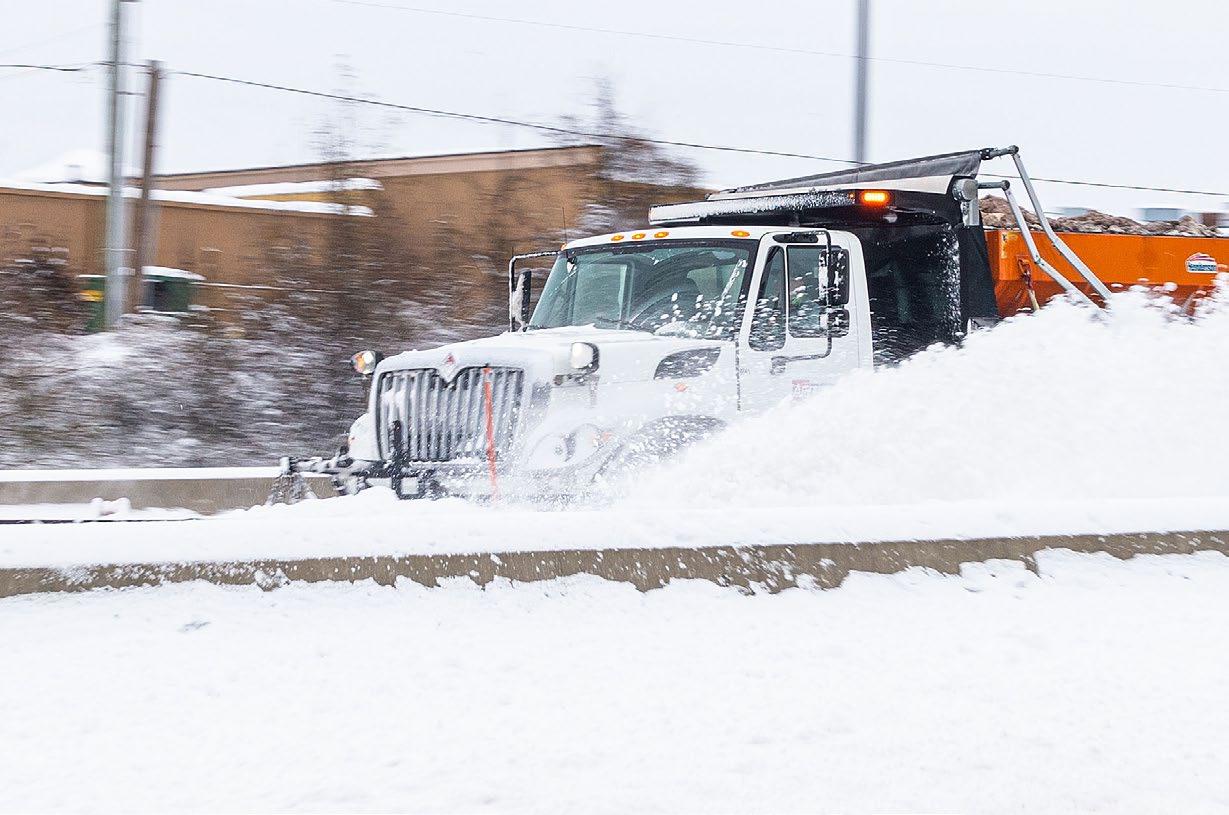
The drills held in December began in the Emergency Operations Center
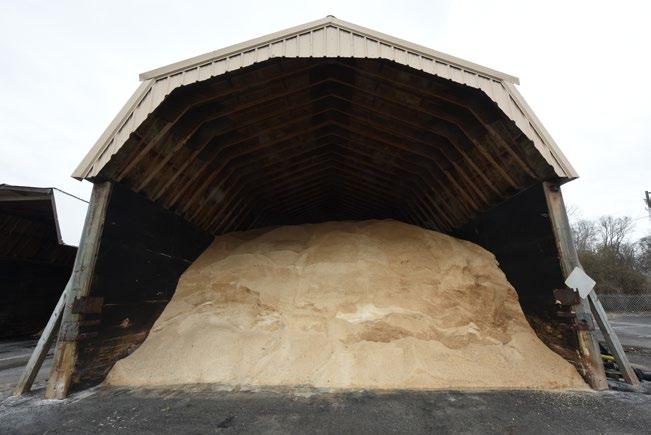
(EOC) housed in the Maintenance Division building at Central Office. It is here that coordinators assessed a winter weather scenario and devised a plan of action for the highways affected including Interstates 30, 40, 430, 440, 630 and Highway 67. That plan involved prioritizing what highways to clear, assigning teams to those highways and planning work shifts for team members. Then it was time for crews to hit the road.
Once on the highways, personnel in the EOC can easily communicate with their teams and also track their location using a wall of video monitors.
“I think the drill went very well,” stated Michael Kelly, Staff Maintenance Engineer and Emergency Management Liaison Officer. “We identified some strengths and areas for improvement that will now make us an even better team moving forward.”
ArDOT’s online resource, IDriveArkansas, has become a popular and reliable site for year-round travel information. During the cold weather months when snow and ice are falling, it is the “go to” source for road conditions and traffic information.

When icy precipitation is falling, a visit to IDriveArkansas will tell you what current road conditions are on our highways, give you up-todate weather conditions and reveal how well traffic is moving. A network of 350-plus video cameras provides a live view of roadways in many areas.
Soon, a new feature called “Plow Tracker” will make its debut on the IDrive site. This feature will allow viewers to see the location of snowplows in all ten ArDOT Districts as they clear the state’s highways. The plows will be represented by a truck icon on the map of Arkansas.

“All plows will use the Department’s fleet tracking software Verizon Connect Reveal,” Denise Powell, Digital Content Coordinator in the Public Information Section, shared. “It will be a “live” tracker updating every 30 seconds and the icons on the map will also indicate which direction the plows are traveling.”
The new feature is expected to debut soon and will benefit motorists by indicating where ArDOT snowplows are running in relation to their own vehicle’s location.

AS YOU READ THIS ISSUE OF ARKANSAS HIGHWAYS MAGAZINE, TRAFFIC IS FLOWING OVER THE ARKANSAS RIVER ON ONE OF TWO NEW BRIDGES PLANNED AS PART OF ArDOT’S 30 CROSSING PROJECT IN DOWNTOWN LITTLE ROCK/NORTH LITTLE ROCK.
While work begins on the second bridge, being constructed adjacent to the first new bridge which is now carrying all traffic, crews with Kiewit-Massman Constructors (KMC) have begun removal of the old Interstate 30 Bridge.
Construction crews initiated demolition of the existing Arkansas River Bridge in September 2022.

The first step of the demolition process involved breaking the concrete deck into smaller pieces using excavators. The rubble fell into a barge under the bridge and was hauled downriver to a port and unloaded.
In the second stage, which began in October, crews began cutting and removing structural steel using a crane. The steel
is being taken off of the river and sent to a scrap yard. In the third stage of the project, an excavator will break piers to the waterline and haul off the debris. The fourth and final step blasts the piers under the waterline and removes the final debris that is in the river navigation channel.
“The demolition of the old Interstate 30 Bridge over the Arkansas River is progressing extremely well,” Keli Wylie, Alternative Project Delivery Administrator, shared. “The entire concrete deck has been removed and crews are currently working on dismantling and removing the structural steel.”
Demolition efforts have been a 24 hour-per-day operation during the work week. The concrete-breaking stage had to take place between 6 a.m. and 8 p.m. to minimize noise during nighttime hours.
In addition to demolition operations over the river, crews also had the challenge of carrying out demolition above city streets in Little Rock and North Little.
“The biggest challenge of this activity was the need to close the city streets below the demolition,” Wylie shared. “Those
closures were carefully coordinated with the cities of Little Rock and North Little Rock to minimize traffic and pedestrian disruptions to the maximum extent possible. Once the street was closed, the contractor had to protect it from any potential damage from the falling concrete and other construction debris. When the demolition was complete, the cleanup began, and the street was reopened as quickly as possible. ARDOT and KMC have maintained a collaborative relationship with both cities and the communication has been seamless.”
Demolishing the piers below the water surface and their removal will follow a different strategy.
“Once the bridge piers have been demolished, the contractor will use an excavator equipped with a long reach boom positioned on a floating barge in the Arkansas River to retrieve concrete debris from the bottom of river,” Wylie explained. “It will then be placed on a barge to be transported to the riverbank for disposal.
Wylie stated complete removal of all debris below the surface is a thorough process.
“Prior to demolition activities, the contractor mapped the bottom of the river using sonar equipment. Once the contractor has completed the cleanup, additional surveys and mapping will occur to verify that the river bottom has been restored to its condition prior to demolition.”
The contractor is simultaneously demolishing the old bridge and constructing the new bridge at the same location.

“Overall, KMC has done a wonderful job of executing their planned work in a timely and efficient manner with minimum disruptions to traffic. The demolition of the bridge is on schedule. In fact, after over two years of construction, the contractor is on schedule almost to the day, with an expected completion date of mid 2025” Wylie shared.
Once the 30 Crossing bridges are complete, each direction of travel will have three through lanes, two collector/distributer lanes, an auxiliary lane—for a total of 12 lanes—and full width shoulders all around.
The project will provide motorists with a safer, more efficient corridor through the downtown area.

Governor Asa Hutchinson joined members of the Arkansas Highway Commission and Congressman Steve Womack October 13 to turn dirt on what will be the Interstate 49/ Highway 22 Interchange in Barling.
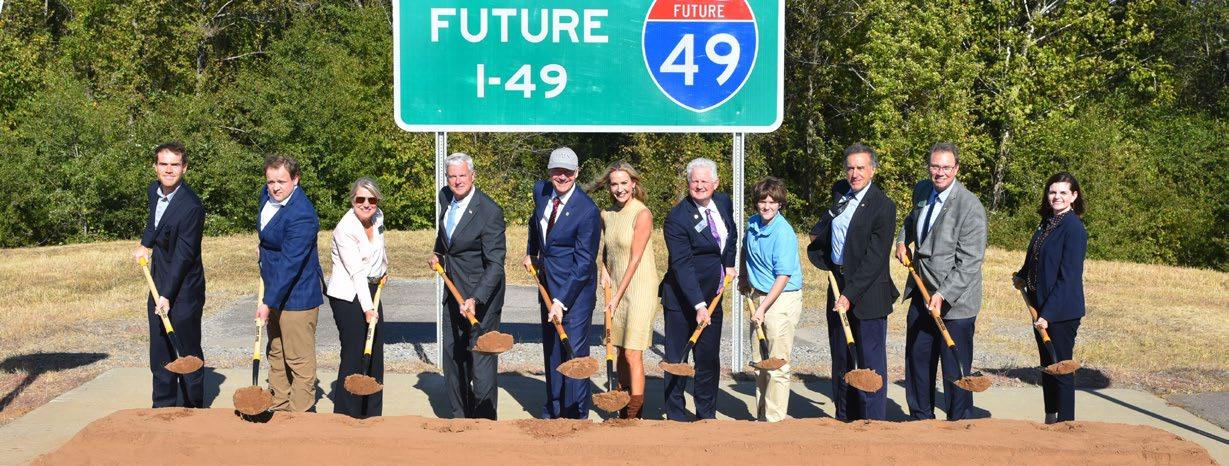

When complete, this new section of I-49 in west Arkansas will be 13.6 miles long and include a new bridge over the Arkansas River. The work will take place in multiple phases over the next several years.
“I know many of us here, myself included, have said we didn’t think we would see this segment and this bridge in particular
Local dignitaries, A r DOT staff and Highway Commissioners came together at the Clark County Courthouse on October 14 to break ground on a new Arkadelphia Bypass.
The new bypass will begin just east of Interstate 30, extend eastward around the south side of town, and extend north to tie into Highway 51¬ just east of 10th Street. It will be approximately four miles in length. McGeorge Contracting Company, Inc. was awarded the contract for the project at $56.1 million.
“A r DOT is fortunate enough to have had several partners working with us to get
BY BRITNI PADILLA-DUMAShappen in our lifetime,” Arkansas Highway Commissioner Keith Gibson of Fort Smith said. “Well folks, it’s going to happen; we’re here to see it through.”
A r DOT awarded Taylor-Hendrix, LLC of Hope, Arkansas, the $891,453 contract to clear vegetation and debris around the site that will become the interchange.
An estimated $270 million from the recently passed Issue1 will fund the future 13.6 miles of new Interstate between Barling and Alma.
us to where we are today,” Commissioner Robert Moore told the crowd. “We wouldn’t be standing here today if we didn’t have the City of Arkadelphia and
your Clark County Office pitching in on these improvements.” Completion on the bypass is expected in the spring of 2027. AS DRIVERS, WE ALL ENCOUNTER INTERSECTIONS
DURING OUR DAILY COMMUTE, AND THE ARKANSAS DEPARTMENT OF TRANSPORTATION (ArDOT) STRIVES TO HELP CITIZENS TRAVEL THROUGH THESE INTERSECTIONS AS SAFELY AND EFFICIENTLY AS POSSIBLE. As communities in Arkansas begin to grow, their roadway needs may change. In an effort to help improve and update intersections within qualifying areas, ArDOT created a program to partner with local communities that recently received updated funding guidelines.
Ar DOT’s Intersection Improvement Program (IIP) was created in 2005 to help communities improve their intersections. This program provides funds for projects in unincorporated and metropolitan areas that have a population of less than 200,000 people. The main goal of this program is to partner with local governments to make these updates to intersections more accessible.
Last year, it was determined that changes needed to be made to help increase the funding available while also making it more accessible to the communities that could benefit from improvements to their intersections.

The following revisions were approved for the IIP in May 2022:
• The amount of money made available through Federal-aid funding was increased from $2,000,000 to $4,000,000 for each Federal Fiscal Year.
• The maximum federal funding available per project was increased from $350,000 to $1,000,000.
• The federal funding is now able to be utilized for all phases of an IIP project, including preliminary engineering, right of way acquisition, utility relocation, construction, and construction engineering and inspection. Previously, the local agency requesting the improvement would be responsible for 100% of the cost of any right of way acquisition and utility relocation.
Eligible projects include the construction of new traffic signals, the upgrade of existing traffic signals, the creation of new roundabouts, updated traffic signal coordination and other minor improvements. Under this program, any new intersection must meet the Manual on Uniform Traffic Control Devices (MUTCD) signalization warrants to qualify for signalization. Ar DOT will design the project, award the construction contract, and then inspect each project as an eligible project expense. Projects that meet the eligibility criteria are funded 80% by Federal-aid, followed by a 10% State and 10% local match. Normally, once the local government requests an intersection improvement project, it takes roughly 3-4 years to reach completion.
Since 2005, nearly $15 million of federal funds, $2.3 million in state funds and $3.1 million in local funds have been used to improve 55 intersections across the state. Funds for the program are available to eligible sponsors year-round. For more information, contact Ar DOT’s Program Management Division at LFPA@ardot.gov or call 501-569-2481.
Federal funds of up to $1,000,000 are available per intersection project.
ASK RESIDENTS OF NORTHWEST ARKANSAS WHAT THEY REMEMBER ABOUT THE DATE APRIL 28, 2021, AND MANY WILL TELL YOU THAT WAS THE DAY NORTHWEST ARKANSAS WAS INUNDATED WITH HEAVY RAINS THAT CAUSED WIDESPREAD FLASH FLOODING. The National Weather Service in Tulsa reported that the storm system dropped 1 to 3 inches of rain across most of the area by mid-morning with 2 to 4 more inches forecasted for the rest of the day. A report of a tornado was also a part of the stormy weather that day.
Swift water rescues were reported in some areas. Numerous highways were reported to be under water throughout the day including Highways 112, 612 and 264. Other roadways had fallen trees blocking traffic.
Recognizing that extreme weather events like the one in Arkansas are becoming more frequent due to climate change, the U.S. Department of Transportation announced in August 2022 $513.2 million in Emergency Relief Funding for roads and bridges damaged by natural disaster and catastrophic events across the country.
“Climate change impacts the lives of Americans on a
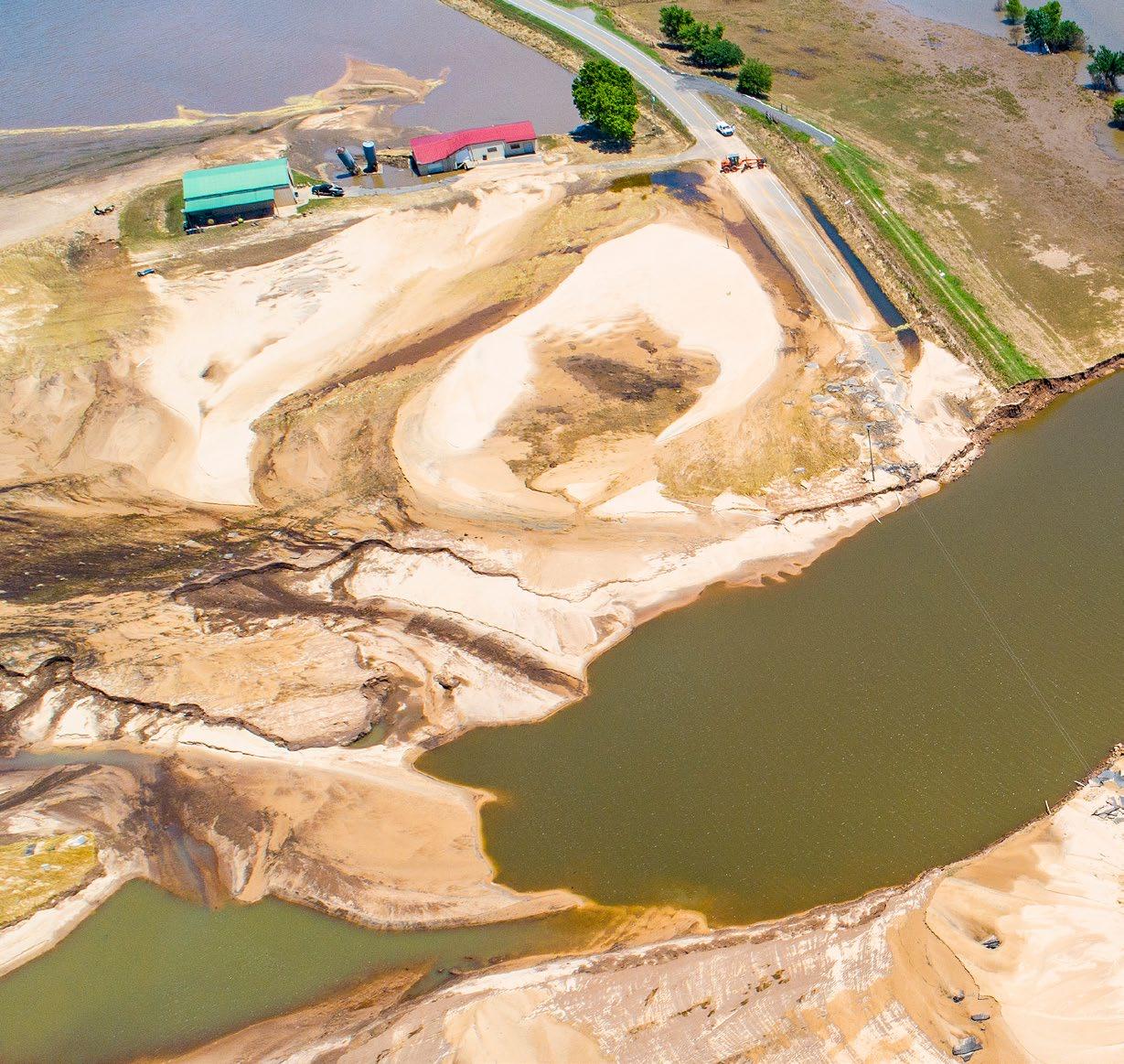
daily basis and has increasingly meant that our nation’s transportation infrastructure is facing more frequent and unpredictable damage from severe weather events,” Acting Federal Highway Administrator Stephanie Pollack said. “The Emergency Relief funding the Administration is announcing today will overwhelmingly go toward repairing damage to roads and bridges relied upon by communities across the country.”
The bulk of FHWA’s Emergency Relief funding goes toward reimbursement for states, territories, federal land management agencies and tribal governments to fix and restore roads and bridges in the aftermath of wildfires, hurricanes, flooding and
other weather-related events.
In September of last year, the USDOT announced $11.9 million in emergency relief funding for Arkansas for roads and bridges damaged by the April 2021 storm.
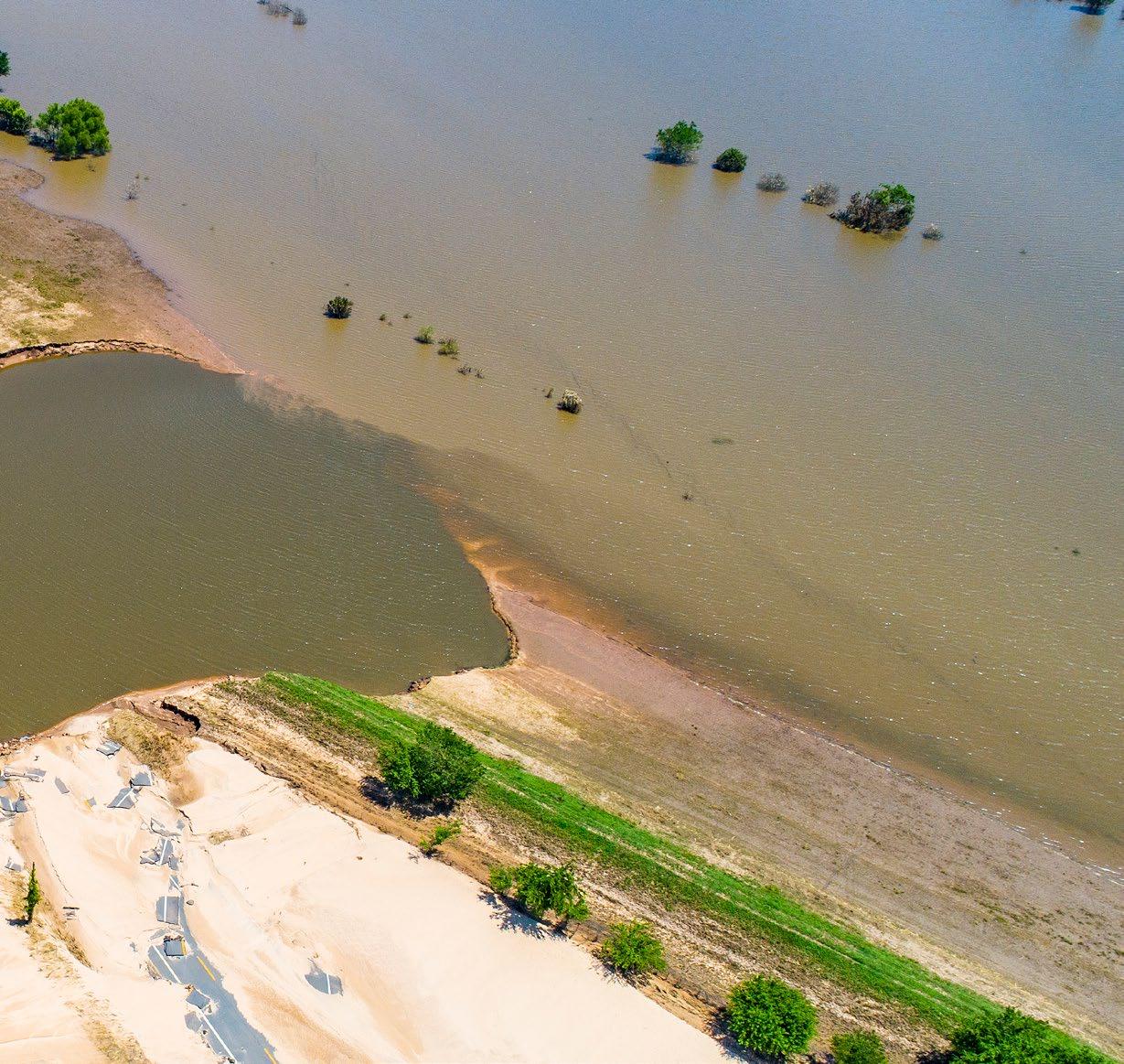
“A total of approximately $10 million will assist the Department with the cost of repairing damages on our Arkansas highways from that storm,” ArDOT Public Information Officer Dave Parker stated. “Approximately $1.9 million will go to the Forest Service.”
The amounts are based on specific damages and repair estimates following the floods.
EVERYONE, AT ONE POINT OR ANOTHER, HAS EXPERIENCED SITTING IN TRAFFIC BECAUSE OF A WRECK ON THE HIGHWAY. Sometimes you are able to move through a decent pace, and other times the interstate can feel like a parking lot. Either way, first responders are doing their best to manage the scene safely and efficiently thanks to Traffic Incident Management (TIM).
WHAT?
The Federal Highway Administration (FHWA) defines TIM as a process that consists of a planned and coordinated multi-disciplinary process to detect, respond to and clear traffic incidents so
that traffic flow can resume as safely and quickly as possible.

ArDOT’s TIM program partners with multiple agencies to enhance responder safety, clear traffic incidents safer and faster, reduce the risk of secondary crashes and ultimately supports the economic vitality of the state by minimizing roadway delays.
WHY?
“Traffic incidents are the leading cause of death for law enforcement and emergency services responders in the U.S.,” explained First Lieutenant Brad Perkins of the Arkansas Highway Police. “Engaging in TIM training and implementation will save lives, save time and save money.”
First responders actually developed and
designed the National TIM Responder Training Program based on first-hand experience and years of institutional knowledge. The goal of the program is to promote consistent training of all responders to achieve clearance, and prompt and reliable, communications.
“Efficient incident response requires seamless collaboration and coordination among responders, law enforcement and recovery operations,” Perkins said. “We need to meet the needs of those injured, ensure the safety of responders and road users, quickly clear the incident and prevent secondary crashes.”
WHO?
TIM courses are relevant for many professions, including communications, emergency management, emergency
A planned and coordinated multi-disciplinary process to detect, respond to, and clear traffic incidents so that traffic flow can resume as safely and quickly as possible.medical services (EMS), fire/rescue, law enforcement, towing and recovery, transportation and public works.
The initial TIM class is a four-hour course from the Federal Highway Association; all trainers are FHWA certified. The International Association of Chiefs of Police (IACP), the International Association of Fire Chiefs (IAFC), the American Association of State Highway and Transportation Officials (AASHTO), the National Volunteer Fire Council (NVFC), the International Association of Directors of Law Enforcement Standards and Training (IADLEST), and the Towing and Recovery Association of America (TRAA) all endorse the TIM training program.
ArDOT’s TIM trainers are working to
create several Advanced TIM classes that address specific challenges and offer hands-on scenarios to offer responders a chance to practice new skills in a safe environment.
“The bottom line is simple: it’s our job to secure a scene, assess the situation, offer aid where it’s needed, communicate with one another and the public about what’s happening, get everyone and everything, like debris or spills off the road, and do so in a way that prevents or minimizes secondary crashes from occurring,” Perkins explained. “It’s a lot, but it’s possible.
The more people we can put through TIM training, the closer we get to consistently achieving our goals.”

THE BOTTOM LINE IS SIMPLE: IT’S OUR JOB TO SECURE A SCENE, ASSESS THE SITUATION, OFFER AID WHERE IT’S NEEDED, COMMUNICATE WITH ONE ANOTHER AND THE PUBLIC ABOUT WHAT’S HAPPENING, GET EVERYONE AND EVERYTHING, LIKE DEBRIS OR SPILLS OFF THE ROAD, AND DO SO IN A WAY THAT PREVENTS OR MINIMIZES SECONDARY CRASHES FROM OCCURRING. .
- Brad Perkins,First
Lieutenant Arkansas Highway Police
 BY BRITNI PADILLA-DUMAS
BY BRITNI PADILLA-DUMAS
THE ARKANSAS DEPARTMENT OF TRANSPORTATION IS PROUD TO SHARE THE OFFICIAL DESIGNATION OF UNITED STATES BIKE ROUTE (USBR) 80 THROUGH ARKANSAS, MARKING THE STATE’S FIRST NATIONALLY RECOGNIZED BICYCLE ROUTE. USBR 80 begins in Little Rock, where the Big Dam Bridge crosses the Arkansas River, and ends in West Memphis, on the Mississippi River at the Tennessee border. Along the way, it passes through rural areas and historical downtowns of the Arkansas Delta.
“The designation of USBR 80 from North Little Rock to the Tennessee state line is the first USBR designation in Arkansas and the first segment of USBR 80 designated in the country,” explained Rex Vines, ArDOT Deputy Director and Chief Engineer and member of the Special Committee on U.S. Route Numbering. “The establishment of a statewide bikeway network, including USBR corridors, is part of the implementation effort for the Arkansas State Bicycle and Pedestrian Transportation Plan.”
The USBR System is a project to create publicly accessible bicycle travel routes across the country with the goal of building broad support for bicycling and bicycle travel in communities nationwide. Experts have planned a 50,000-mile network of bicycle routes following urban streets, county roads, greenways, trail systems and state highways for the purpose of long-distance (multi-state) bicycle travel. Routes of four planned corridors will cross through Arkansas: USBR 80, 51, 45 and 84. USBR 80 is a planned corridor from North Carolina to Oklahoma and the routes in Arkansas are a two-phase plan; Phase 2 would connect North Little Rock to the Oklahoma state line (though additional planning and coordination are required to identify a route).
“Designating USBR 80 will increase bicycle tourism and further then-Governor Hutchinson’s efforts to promote Arkansas as a bicycle hub,” said Deputy Director Vines. “It will also enhance the state’s ranking among bicycle friendly states and improve the overall east/west USBR connectivity across the country.”

DESIGNATED U.S. BICYCLE ROUTE
Established U.S. Bicycle Route designated by AASHTO.
These corridors are not routes, but 50-mile wide areas where a route may be developed.
0
100
The establishment of a statewide bikeway network, including USBR corridors, is part of the implementation effort for the Arkansas State Bicycle and Pedestrian Transportation Plan. USBR 80 was possible with support from the Cities of England, Marianna, North Little Rock, Stuttgart and West Memphis, and Lonoke, Crittenden and Pulaski Counties.
“Collaboration and partnership across state agencies and other stakeholders play crucial roles in the creation and designation of a route like USBR 80,” said Jennifer Hamelman, USBRS Program Manager at Adventure Cycling, “These efforts lead to the most satisfying results for bicycle travelers across the country.”
Additionally, there are no funding requirements to federally recognizing bicycle routes in Arkansas. Most of the locations identified for USBR 80 are low-volume highways with sufficient shoulder width for bicycle travel, so no impacts to motor vehicle travel are anticipated.

Since AASHTO approved the USBR National Corridor Plan in 2008, the System has grown to nearly 19,000 total miles.
USBR 51 is one of two planned corridors from Minnesota to Louisiana. In Arkansas, the proposed route traverses the western part of the state, potentially connecting the Northwest Arkansas, Fort Smith and Texarkana metropolitan areas, potentially following the alignment of Highway 71.
USBR 45 (the second corridor from Minnesota to Louisiana) generally follows the Mississippi River. Existing and proposed routes and trails in Arkansas, including the Delta Heritage Trail and Mississippi River Trail, are under consideration.
Finally, USBR 84 is a planned corridor from South Carolina to Texas. The proposed route in Arkansas traverses the southern part of the state, potentially following the general alignment of Highway 82 or Highway 278.
Adventure Cycling Association is the only non-profit organization that coordinates national development of the U.S. Bicycle Route System. Adventure Cycling has provided support to the U.S. Bicycle Route System since 2005, including research, meeting coordination and technical guidance for states implementing routes.
 BY BRITNI PADILLA-DUMAS
BY BRITNI PADILLA-DUMAS


AMERE HALF-MILE SOUTH OF THE ARKANSAS-MISSOURI BORDER LIES THE TOWN OF MAMMOTH SPRING AND THE SPRING RIVER; ITS SOURCE BEGINS AS RAINFALL IN SOUTHERN MISSOURI, FLOWS THROUGH GRAND GULF STATE PARK’S UNDERGROUND CAVE SYSTEM NEAR THAYER, MISSOURI, AND REEMERGES AS MAMMOTH SPRING IN ARKANSAS. T he waters from the park’s spring form the scenic Spring River, one of Arkansas’ most popular trout rivers. It is Arkansas’ largest spring and the second largest in the Ozarks. Mammoth Spring flows at an average rate of nine million gallons per hour with a constant water temperature of 58° Fahrenheit.
 Mammoth Spring Fish Hatchery
A Longnose Gar greets visitors to the Hatchery.
Photo courtesy of Arkansas Parks & Tourism
Mammoth Spring Fish Hatchery
A Longnose Gar greets visitors to the Hatchery.
Photo courtesy of Arkansas Parks & Tourism
In addition to the rainbow trout found in its upper stretches and the walleye and bass in its lower reaches, the Spring River is rated one of the state’s best float streams for canoes, kayaks and rafts. The constant water flow from the spring makes it a good float stream year-round.
Drop into the MAMMOTH SPRING STATE PARK WELCOME CENTER located at 17 Highway 63 North for information on what there is to do in the park. Step out the back door and walk the interpretive trail that circles around the park. Along the way, you’ll see the spring pool, paddle boats and then a hydroelectric plant built in 1927 that supplied power to the local area. You can then walk across the dam built in 1888 and see the headwaters spilling forth, creating the Spring River.

Above the loop trail is an overlook where you can check out the entire spring area. Adjacent to the park is the 1886 FRISCO TRAIN DEPOT MUSEUM. This turn-of-the-century building is the oldest train depot in Arkansas and was the hub of the community. The town of Mammoth Spring flourished in part due to this small railroad depot. Storyboards found inside the depot share information about the steam locomotives that passed through the area in days gone by. Short audio presentations complement each display, and a couple of short videos tell the history of Mammoth Spring. The old baggage room features a wide variety of railroad artifacts; the depot is open Wednesday through Sunday.
The U.S. Fish and Wildlife Service operates the MAMMOTH SPRING NATIONAL FISH HATCHERY AND AQUATIC CONSERVATION CENTER. Federal funding allows the hatchery to conduct programs like spawning endangered pallid sturgeon and Ozark hellbender salamanders. The Aquatic Conservation Center opened in 2014 and is filled with numerous water tanks displaying fish found in the area.

To see trout up close, visit the JIM HINKLE SPRING RIVER STATE FISH HATCHERY. The hatchery rests on a sevenacre island on the Spring River just below Dam #3. It is one of five hatcheries owned by the Arkansas State Game and Fish Commission and is the State’s only cold-water hatchery. The Kroger Company donated the property to Arkansas in 2003. Today, it is one of the largest trout hatcheries in the southeast and features twenty-one raceways, or rectangular ponds, and
forty-seven in ground silos, or round tanks. Using Mammoth Spring as its water source, the hatchery produces rainbow and cutthroat trout and raises them to a length of anywhere from eight to eleven inches. On a typical day, the hatchery sends out eight- to ten-thousand fish—that’s more than a million fish to waters in a year! Fifty percent of all the rainbow trout stocked in Arkansas are raised at the Spring River facility. The fish hatchery is open every day except Sunday and is located at 895 State Highway 342, just south of Mammoth Spring.
The best way to fish the river downstream from the dam is from a canoe. The first three miles below Dam #3 provide the best action and the biggest fish—one-pound to three-pound rainbows are fairly common, with trout and walleye fishing said to be top notch. Fly fishing is also very popular.


ON SEPTEMBER 29, 2022, ArDOT HOSTED A PUBLIC INVOLVEMENT MEETING IN ALMA TO SHARE WITH CITIZENS THE PROPOSED PLANS FOR THE DEVELOPMENT OF INTERSTATE 49 BETWEEN HIGHWAY 22 IN SEBASTIAN COUNTY AND INTERSTATE 40 IN CRAWFORD COUNTY.

Like any other public meeting, this one showcased the project design, the timeline, a fly-through video and other extremely important information. However, people who attended this meeting also got to experience something new from the Department. By partnering with design firm HNTB, ArDOT was able to let people experience a virtual version of the finished project by using VR (Virtual Reality) headsets.
According to Marisol Filares Arreguin, ArDOT GIS (Geospatial Information Systems) & Data Management Specialist, “HNTB used a combination of advanced technologies such as surveygrade UAV data, GIS and Autodesk to bring the design to life. The implementation of VR gives meeting attendees a deeper comprehension of how a project will look in the future after construction without needing to have an engineering
Meeting attendees were given the opportunity to don VR headsets and study 3D models of the design from a vantage
As of now, there are no ongoing VR implementation projects, but discussions are being made to implement VR setups for future high-level construction jobs.

Readers can experience the Alma virtual meeting from home by navigating to ArDOT’s main website at www.ardot.gov and clicking on the “Events Feed” tab. Then, find the meeting by searching for job number “040748.” Select the event dated September 29, 2022. Scroll down the page and click the “Virtual Room” button. Through this, readers with and without VR headsets will be able to see an example of what the extension might look like when finished.

The Barkays
As you travel Arkansas over the next few months, consider checking out some of these listed events. Our State is full of interesting things to do, no matter what highway you take. For additional event listings, check out Arkansas.com/events
THE BARKAYS: With a career total of 29 albums, including five gold and one platinum, 40 single releases and 20 top ten singles and albums, the BAR-KAYS remain one of the hardest working and most honored groups around. • FEBRUARY 18

JURASSIC PARK IN CONCERT: Experience the action-packed adventure of Jurassic Park in HD accompanied by a full symphony orchestra performing John Williams’ iconic score live. • MARCH 4
DIEGO RIVERA’S AMERICA: An exhibition examining the artist’s life through over 170 works including his drawings, easel paintings, frescoes and more. This is the first major exhibition focused solely on the Mexican artist in over 20 years.

MARCH 11 – JULY 31
20TH ANNUAL WORLD’S SHORTEST ST. PATRICK’S DAY PARADE: Join actor Christopher McDonald as he fires the starter’s pistol for the First Ever 20 th Annual World’s Shortest St. Patrick’s Day Parade. Country music superstar Justin Moore is this year’s celebrity grand marshal along 98-foot Bridge Street. • MARCH 17

FEBRUARY 18
THE BARKAYS
East Arkansas Community College
Fine Arts Center
Forrest City
MARCH 4
JURASSIC PARK IN CONCERT
Perot Theatre
Texarkana, AR
MARCH 4 & 5
LITTLE ROCK MARATHON WEEKEND

Downtown
Little Rock, AR
MARCH 11 - JULY 31
DIEGO RIVERA’S AMERICA
Crystal Bridges Museum of American Art
Bentonville, AR
MARCH 13 - 14
LEARN POTTERY ON A POTTER’S WHEEL
Ozark Folk Center State Park
Mountain View, AR
MARCH 17
FIRST EVER 20th ANNUAL WORLD’S SHORTEST
ST. PATRICK’S DAY PARADE Bridge Street
Hot Springs, AR
CREWS WITH TANNER CONSTRUCTION COMPANY, INCORPORATED, HAVE SUBSTANTIALLY COMPLETED CONSTRUCTION ON APPROXIMATELY ONE MILE OF HIGHWAY 367 IN NEWPORT THAT INCLUDES A NEW BRIDGE OVER THE WHITE RIVER. The work was completed in late September of 2022 at a cost of $31.3 million.


The new bridge spans a length of 2,640 feet and a width of 40 feet. Construction features include 18 bents, two piers and six deck units. Due to its proximity to the New Madrid Fault and earthquake zone, the new bridge incorporates modern seismic design standards including the use of seismic isolation bearings, restrainer blocks and spiral reinforcing steel.
The project required moving over 83,000 cubic yards of earthwork. The completed bridge includes 14,543 cubic yards of concrete and 12,290,744 pounds of steel.
The old bridge served motorists for 93 years. Future plans for the structure have yet to be determined.

am a landowner whose property is bisected by Arkansas Highway 7 just north of the town of Dover.
For the past 3 years, I have had a beaver problem where a ditch passes under Highway 7 through a large box culvert. The dam was located on the right of way very near the mouth of the box culvert. The dam created a pond which prevented access except from the highway right of way.
I called the A r DOT District 8 office in Russellville and was referred to David Tolleson, Maintenance Engineer. I explained the situation and he told me he would have a look. Two days later, a truck with an excavator pulled up and went to work.
The dam was in a very difficult place to access but the A r DOT crew worked until they had effectively removed the dam. This was not an easy task. At one point, they had to change to a more experienced operator to get it done but get it done they did.
I know you must get many complaints and I myself reserve the right to complain when it is warranted. However, I must also complement a good job when it is done. This letter is to complement District 8, Mr. Tolleson and the crew (I do not know their names) who performed the actual work, on a job well done. I thank you all for the good work.
Sincerely,
Gary ChurchillThis letter was received in February 2022.

We offer our sincere thanks for your collaboration with the City of Pine Bluffs Street Department in facilitating the Heartsaver First Aid CPR AED training classes for City staff. We recognize that this training is essential because knowledge of CPR can save lives.
The recent CPR training class facilitated on March 16th was most successful, and City staff are looking forward to additional sessions. Fortunately, I was able to sit in on one of the sessions for a few minutes. I was most impressed with the presenters' ability to engage the participants in these life saving exercises.
Again, thank you for the opportunity to partner with your organization and equip our workforce with this life-saving knowledge.
Regards,
Shirley Washington
Mayor of Pine Bluff
This letter was received in March 2022.
Whoever the Highway Department employees were that cut our roadsides and ditches last week, you should be employees of the month. Great Job! Best ever! Thanks for helping to keep our roads and highways looking good.
Carolyn Bickerstaff
(Facebook Commenter)
This post was made in July 2022.
Thank you for sharing the summer edition of Arkansas Highways with us. It was a thrill to see the Blue Swallow Motel mentioned in the Route 66 article!
Thanks again, Dawn & Robert Federico
Blue Swallow Motel
Tucumcari, New Mexico
This letter was received in October 2022.
Arkansas Department of Transportation

P.O. Box 2261
Little Rock, AR 72203-2261
FORWARDING SERVICE REQUESTED